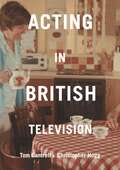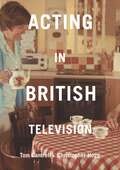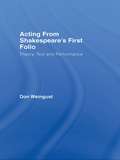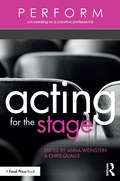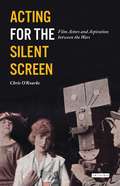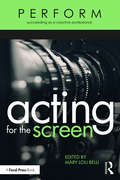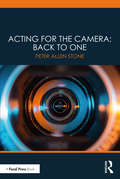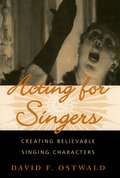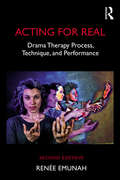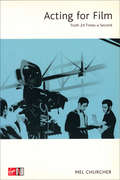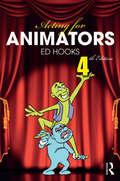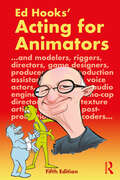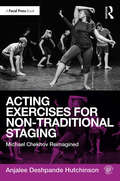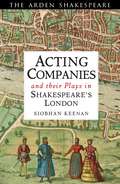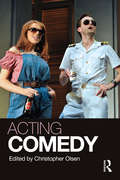- Table View
- List View
Acting in British Television
by Tom Cantrell Christopher HoggActing in British Television is the first in-depth exploration of acting processes in British television. Focused around sixteen new interviews with celebrated British actors, including Rebecca Front, Julie Hesmondhalgh, Ken Stott, Penelope Wilton and John Hannah, this fascinating text delves behind the scenes of a range of British television programmes in order to find out how actors build their characters for television, how they work on set and location, and how they create their critically-acclaimed portrayals. The book looks at actors’ work across four diverse but popular genres: - soap opera - police and medical drama - comedy - period drama Its insightful discussion of hit programmes such as Downton Abbey, Rebus, The Thick of It, Coronation Street and Poldark, and its critical and contextual post-interview analysis, makes the text an essential read for students, academics and anyone interested in acting and British television.
Acting in British Television
by Tom Cantrell Christopher HoggThis fascinating text offers the first in-depth exploration of acting processes in British television. Focused around 16 new interviews with celebrated British actors, including Rebecca Front, Julie Hesmondhalgh, Ken Stott, Penelope Wilton and John Hannah, this rich resource delves behind the scenes of a range of British television programmes in order to find out how actors build their characters for television, how they work on set and location, and how they create their critically acclaimed portrayals. The book looks at actors' work across four diverse but popular genres: soap opera; police and medical drama; comedy; and period drama. Its insightful discussion of hit programmes and its critical and contextual post-interview analysis, makes the text an essential read for students across television and film studies, theatre, performance and acting, and cultural and media studies, as well as academics and anyone interested in acting and British television.
Acting from Shakespeare's First Folio: Theory, Text and Performance
by Don WeingustActing from Shakespeare's First Folio examines a series of techniques for reading and performing Shakespeare's plays that are based on the texts of the first ‘complete’ volume of Shakespeare's works: the First Folio of 1623. Do extra syllables in a line suggest how it might be played? Can Folio commas reveal character? Don Weingust places this work on Folio performance possibility within current understandings about Shakespearean text, describing ways in which these challenging theories about acting often align quite nicely with the work of the theories' critics. As part of this study, Weingust looks at the work of Patrick Tucker and his London-based Original Shakespeare Company, who have sought to discover the opportunities in using First Folio texts, acting techniques, and what they consider to be original Shakespearean performance methodologies. Weingust argues that their experimental performances at the Globe on Bankside have revealed enhanced possibilities not only for performing Shakespeare, but for theatrical practice in general.
Acting from Shakespeare's First Folio: Theory, Text and Performance
by Don WeingustActing from Shakespeare's First Folio examines a series of techniques for reading and performing Shakespeare's plays that are based on the texts of the first ‘complete’ volume of Shakespeare's works: the First Folio of 1623. Do extra syllables in a line suggest how it might be played? Can Folio commas reveal character? Don Weingust places this work on Folio performance possibility within current understandings about Shakespearean text, describing ways in which these challenging theories about acting often align quite nicely with the work of the theories' critics. As part of this study, Weingust looks at the work of Patrick Tucker and his London-based Original Shakespeare Company, who have sought to discover the opportunities in using First Folio texts, acting techniques, and what they consider to be original Shakespearean performance methodologies. Weingust argues that their experimental performances at the Globe on Bankside have revealed enhanced possibilities not only for performing Shakespeare, but for theatrical practice in general.
Acting for the Stage (PERFORM)
by Anna Weinstein Chris QuallsActing for the Stage is a highly accessible guide to the business of theater acting, written for those interested in pursuing acting as a profession. This book is a collection of essays by and interviews with talented artists and businesspeople who have built successful careers in the theater; it’s a goldmine of career advice that might take years to find on your own. Herein, the myths around professional acting are dispelled, and the mysteries revealed. Acting for the Stage illuminates practical strategies to help you build a life as a theater professional and find financial rewards and creative fulfillment in the process. Contains essays by and interviews with working stage actors, acting coaches, directors, writers, and agents. Features discussions on selecting a graduate school program, choosing acting classes and workshops, making the most out of your showcase, landing an agent, networking and promoting yourself, and the business of casting. Covers issues of money management, balancing the highs and lows of the profession, finding work to nourish your acting career, and building your creative team and support network.
Acting for the Stage (PERFORM)
by Anna Weinstein Chris QuallsActing for the Stage is a highly accessible guide to the business of theater acting, written for those interested in pursuing acting as a profession. This book is a collection of essays by and interviews with talented artists and businesspeople who have built successful careers in the theater; it’s a goldmine of career advice that might take years to find on your own. Herein, the myths around professional acting are dispelled, and the mysteries revealed. Acting for the Stage illuminates practical strategies to help you build a life as a theater professional and find financial rewards and creative fulfillment in the process. Contains essays by and interviews with working stage actors, acting coaches, directors, writers, and agents. Features discussions on selecting a graduate school program, choosing acting classes and workshops, making the most out of your showcase, landing an agent, networking and promoting yourself, and the business of casting. Covers issues of money management, balancing the highs and lows of the profession, finding work to nourish your acting career, and building your creative team and support network.
Acting for the Silent Screen: Film Actors and Aspiration between the Wars (Cinema and Society)
by Chris O'RourkeA young man leaves his home to look for work in the cinema industry and disappears into the anonymity of showbiz rebuffals. A shop girl wins a newspaper competition and is transformed overnight into a transatlantic star. An aristocrat swaps high society for the film studio when she 'consents' to act in a series of films, thus legitimising acting for what some might have considered a 'low' art form. Stories like these were the stuff of newspaper headlines in 1920s Britain and reflected a national 'craze' for the cinema. They also demonstrated radical changes in attitudes and values within British society in the wake of World War I.
Acting for the Screen (PERFORM)
by Mary Lou BelliActing for the Screen is a collection of essays written by and interviews with working actors, producers, directors, casting directors, and acting professors, exploring the business side of screen acting. In this book, over thirty show business professionals dispel myths about the industry and provide practical advice on topics such as how to break into the field, how to develop, nurture, and navigate business relationships, and how to do creative work under pressure. Readers will also learn about the entrepreneurial expectations in relation to the internet and social media, strategies for contending with the emotional highs and lows of acting, and money management while pursuing acting as a profession. Written for undergraduates and graduates studying Acting for Screen, aspiring professional actors, and working actors looking to reinvent themselves, Acting for the Screen provides readers with a wealth of first-hand information that will help them create their own opportunities and pursue a career in show business.
Acting for the Screen (PERFORM)
by Mary Lou BelliActing for the Screen is a collection of essays written by and interviews with working actors, producers, directors, casting directors, and acting professors, exploring the business side of screen acting. In this book, over thirty show business professionals dispel myths about the industry and provide practical advice on topics such as how to break into the field, how to develop, nurture, and navigate business relationships, and how to do creative work under pressure. Readers will also learn about the entrepreneurial expectations in relation to the internet and social media, strategies for contending with the emotional highs and lows of acting, and money management while pursuing acting as a profession. Written for undergraduates and graduates studying Acting for Screen, aspiring professional actors, and working actors looking to reinvent themselves, Acting for the Screen provides readers with a wealth of first-hand information that will help them create their own opportunities and pursue a career in show business.
Acting for the Camera: Back to One
by Peter Allen StoneActing for the Camera: Back to One is a "how to" book with practical steps to achieve a professional performance on camera. The book focuses on four distinct areas: how to prepare the character, how to execute the technical responsibilities that will assist the editor in creating the on-camera performance in post-production, tips from industry professionals, and how to create effective self-tape auditions. Part One: The Character’s World is packed with tools to analyze the script and fully prepare the character before arriving on set. Part Two: The Actor’s World focuses on developing technical acting skills for the camera that assist the pre- and post-production teams to create a dynamic on-screen performance. In Part Three: The Professional World, industry professionals provide tips from inside the film/TV audition room and how to navigate a career in the acting business. The final section, Part Four: Self-Tape Like a Pro, outlines how to build a self-tape studio in the privacy of your own home and submit high-quality self-tape auditions that will help you stand out from the competition. Written for students enrolled in Acting for the Camera courses, Acting for the Camera: Back to One explores techniques that can be practiced and mastered by actors of all levels, from the moment they audition for the part through to when they hear that director call "cut!"
Acting for the Camera: Back to One
by Peter Allen StoneActing for the Camera: Back to One is a "how to" book with practical steps to achieve a professional performance on camera. The book focuses on four distinct areas: how to prepare the character, how to execute the technical responsibilities that will assist the editor in creating the on-camera performance in post-production, tips from industry professionals, and how to create effective self-tape auditions. Part One: The Character’s World is packed with tools to analyze the script and fully prepare the character before arriving on set. Part Two: The Actor’s World focuses on developing technical acting skills for the camera that assist the pre- and post-production teams to create a dynamic on-screen performance. In Part Three: The Professional World, industry professionals provide tips from inside the film/TV audition room and how to navigate a career in the acting business. The final section, Part Four: Self-Tape Like a Pro, outlines how to build a self-tape studio in the privacy of your own home and submit high-quality self-tape auditions that will help you stand out from the competition. Written for students enrolled in Acting for the Camera courses, Acting for the Camera: Back to One explores techniques that can be practiced and mastered by actors of all levels, from the moment they audition for the part through to when they hear that director call "cut!"
Acting for Singers: Creating Believable Singing Characters
by David F. OstwaldWritten to meet the needs of thousands of students and pre-professional singers participating in production workshops and classes in opera and musical theater, Acting for Singers leads singing performers step by step from the studio or classroom through audition and rehearsals to a successful performance. Using a clear, systematic, positive approach, this practical guide explains how to analyze a script or libretto, shows how to develop a character building on material in the score, and gives the singing performer the tools to act believably. More than just a "how-to" acting book, however, Acting for Singers also addresses the problems of concentration, trust, projection, communication, and the self-doubt that often afflicts singers pursuing the goal of believable performance. Part I establishes the basic principles of acting and singing together, and teaches the reader how to improvise as a key tool to explore and develop characters. Part II teaches the singer how to analyze theatrical work for rehearsing and performing. Using concrete examples from Carmen and West Side Story, and imaginative exercises following each chapter, this text teaches all singers how to be effective singing actors.
Acting for Singers: Creating Believable Singing Characters
by David F. OstwaldWritten to meet the needs of thousands of students and pre-professional singers participating in production workshops and classes in opera and musical theater, Acting for Singers leads singing performers step by step from the studio or classroom through audition and rehearsals to a successful performance. Using a clear, systematic, positive approach, this practical guide explains how to analyze a script or libretto, shows how to develop a character building on material in the score, and gives the singing performer the tools to act believably. More than just a "how-to" acting book, however, Acting for Singers also addresses the problems of concentration, trust, projection, communication, and the self-doubt that often afflicts singers pursuing the goal of believable performance. Part I establishes the basic principles of acting and singing together, and teaches the reader how to improvise as a key tool to explore and develop characters. Part II teaches the singer how to analyze theatrical work for rehearsing and performing. Using concrete examples from Carmen and West Side Story, and imaginative exercises following each chapter, this text teaches all singers how to be effective singing actors.
Acting For Real: Drama Therapy Process, Technique, And Performance
by Renée EmunahThis second edition takes the reader further into the heart of using drama for healing. Dr. Emunah offers an expanded understanding of her Integrative Five Phase model, a foundational approach that embraces the wide spectrum of possibilities within the playing field of drama therapy. Grounded by compassionate clinical examples, including ones that reach over time into deep-seated issues, the book offers tools for action-oriented treatment, embodied therapeutic interventions, and creatively engaging a wide variety of clients. This comprehensive text also contains over 120 techniques, categorized by phases in the session and treatment series, and subcategorized by therapeutic objective. Process-oriented drama therapy with group and individuals, as well as performance-oriented forms, are described in vivid detail. New to the second edition is an exploration of drama therapy outside of the clinical arena, including dramatic methods in family life and parenting, and drama therapy geared toward social change.
Acting For Real: Drama Therapy Process, Technique, And Performance
by Renée EmunahThis second edition takes the reader further into the heart of using drama for healing. Dr. Emunah offers an expanded understanding of her Integrative Five Phase model, a foundational approach that embraces the wide spectrum of possibilities within the playing field of drama therapy. Grounded by compassionate clinical examples, including ones that reach over time into deep-seated issues, the book offers tools for action-oriented treatment, embodied therapeutic interventions, and creatively engaging a wide variety of clients. This comprehensive text also contains over 120 techniques, categorized by phases in the session and treatment series, and subcategorized by therapeutic objective. Process-oriented drama therapy with group and individuals, as well as performance-oriented forms, are described in vivid detail. New to the second edition is an exploration of drama therapy outside of the clinical arena, including dramatic methods in family life and parenting, and drama therapy geared toward social change.
Acting For Film: Truth 24 Times A Second
by Mel ChurcherThe author uses her wide experience as an acting and voice coach an major movies to offer insights into the film acting process. She provides tasks, techniques and tips that are designed specifically for film: there's advice to make the first-time film actor feel at home on set, tips on the casting process, how to cope with auditions, on-camera techniques, schedules and shooting order, as well as specific advice from film crews to help an actor's performance. This practical workbook combines exercises and anecdotes in an informal and accessible style, making it the indispensable guide for anyone wishing to light up the silver screen.
Acting for Animators (PDF): 4th Edition
by Ed HooksEd Hooks' essential acting guidebook for animators has been fully revised and updated in this 4th edition. Hooks uses classical acting theory – from Aristotle to Stanislavsky and beyond – to explain everything from character analysis and physical movement to facial expression and scene structure. He speaks directly to animators, instead of stage or screen actors. Acting for Animators is an invaluable primer for beginner animators and a useful reference for experienced pros. New to this fourth edition: - 6 new scene-by-scene acting analyses of animated feature films, including Zootopia and The Little Prince - an annotated analysis of Walt Disney’s famous 1935 memo to Don Graham, regarding how best to train animators - advice to the animator about how best to perform visual references - a chapter on Virtual Reality - an online database of Ed’s previous film analyses, all in one place.
Acting for Animators: 4th Edition
by Ed HooksEd Hooks' essential acting guidebook for animators has been fully revised and updated in this 4th edition. Hooks uses classical acting theory – from Aristotle to Stanislavsky and beyond – to explain everything from character analysis and physical movement to facial expression and scene structure. He speaks directly to animators, instead of stage or screen actors. Acting for Animators is an invaluable primer for beginner animators and a useful reference for experienced pros. New to this fourth edition: - 6 new scene-by-scene acting analyses of animated feature films, including Zootopia and The Little Prince - an annotated analysis of Walt Disney’s famous 1935 memo to Don Graham, regarding how best to train animators - advice to the animator about how best to perform visual references - a chapter on Virtual Reality - an online database of Ed’s previous film analyses, all in one place.
Acting for Animators
by Ed HooksEd Hooks' essential acting guidebook for animators has been fully revised and updated in this fifth edition, capturing some of the vast changes that have affected the animation industry in recent years. Written specifically for animation professionals instead of stage and movie actors, this book provides an essential primer for creating empathetic and dynamic character performance and, in the process, shows how the strongest storytelling structure works. Hooks applies classical acting theory – from Aristotle to Stanislavsky and beyond – to animation, as well as explaining scene structure, character development and the connections between thinking, emotion and physical action. Theory presented here applies to any and all character animation regardless of style or animation technique. Whether your project is stop-motion, 2D, 3D or a blend of techniques, audiences are audiences are audiences, and they have shown up at the theater or cinema so they can experience and enjoy your story. New to this fifth edition: Four new scene-by-scene acting analyses of animated feature films: Flee, Soul, Porco Rosso and The Triplets of Belleville. A comprehensive and updated section titled "Classroom Notes" which includes a segment on experimental animation, a brief history of acting training for actors and guidance on Motion and Performance Capture technology. Updated online database of Hooks' previous film analyses, all in one place. Acting for Animators is essential reading for all students and teachers of animation courses.
Acting for Animators
by Ed HooksEd Hooks' essential acting guidebook for animators has been fully revised and updated in this fifth edition, capturing some of the vast changes that have affected the animation industry in recent years. Written specifically for animation professionals instead of stage and movie actors, this book provides an essential primer for creating empathetic and dynamic character performance and, in the process, shows how the strongest storytelling structure works. Hooks applies classical acting theory – from Aristotle to Stanislavsky and beyond – to animation, as well as explaining scene structure, character development and the connections between thinking, emotion and physical action. Theory presented here applies to any and all character animation regardless of style or animation technique. Whether your project is stop-motion, 2D, 3D or a blend of techniques, audiences are audiences are audiences, and they have shown up at the theater or cinema so they can experience and enjoy your story. New to this fifth edition: Four new scene-by-scene acting analyses of animated feature films: Flee, Soul, Porco Rosso and The Triplets of Belleville. A comprehensive and updated section titled "Classroom Notes" which includes a segment on experimental animation, a brief history of acting training for actors and guidance on Motion and Performance Capture technology. Updated online database of Hooks' previous film analyses, all in one place. Acting for Animators is essential reading for all students and teachers of animation courses.
Acting Exercises for Non-Traditional Staging: Michael Chekhov Reimagined
by Anjalee Deshpande HutchinsonActing Exercises for Non-Traditional Staging: Michael Chekhov Reimagined offers a new set of exercises for coaching actors when working on productions that are non-traditionally staged in arenas, thrusts, or alleys. All of the exercises are adapted from Michael Chekhov's acting technique, but are reimagined in new and creative ways that offer innovative twists for the practitioner familiar with Chekhov, and easy accessibility for the practitioner new to Chekhov. Exploring the methodology through a modern day lens, these exercises are energizing additions to the classroom and essential tools for more a vibrant rehearsal and performance.
Acting Exercises for Non-Traditional Staging: Michael Chekhov Reimagined
by Anjalee Deshpande HutchinsonActing Exercises for Non-Traditional Staging: Michael Chekhov Reimagined offers a new set of exercises for coaching actors when working on productions that are non-traditionally staged in arenas, thrusts, or alleys. All of the exercises are adapted from Michael Chekhov's acting technique, but are reimagined in new and creative ways that offer innovative twists for the practitioner familiar with Chekhov, and easy accessibility for the practitioner new to Chekhov. Exploring the methodology through a modern day lens, these exercises are energizing additions to the classroom and essential tools for more a vibrant rehearsal and performance.
Acting Companies and their Plays in Shakespeare’s London
by Siobhan KeenanActing Companies and their Plays in Shakespeare's London explores the intimate and dynamic relationship between acting companies and playwrights in this seminal era in English theatre history. Siobhan Keenan's analysis includes chapters on the traditions and workings of contemporary acting companies, playwriting practices, stages and staging, audiences and patrons, each illustrated with detailed case studies of individual acting companies and their plays, including troupes such as Lady Elizabeth's players, 'Beeston's Boys' and the King's Men and works by Shakespeare, Jonson, Middleton, Brome and Heywood. We are accustomed to focusing on individual playwrights: Acting Companies and their Plays in Shakespeare's London makes the case that we also need to think about the companies for which dramatists wrote and with whose members they collaborated, if we wish to better understand the dramas of the English Renaissance stage.
Acting Companies and their Plays in Shakespeare’s London
by Siobhan KeenanActing Companies and their Plays in Shakespeare's London explores the intimate and dynamic relationship between acting companies and playwrights in this seminal era in English theatre history. Siobhan Keenan's analysis includes chapters on the traditions and workings of contemporary acting companies, playwriting practices, stages and staging, audiences and patrons, each illustrated with detailed case studies of individual acting companies and their plays, including troupes such as Lady Elizabeth's players, 'Beeston's Boys' and the King's Men and works by Shakespeare, Jonson, Middleton, Brome and Heywood. We are accustomed to focusing on individual playwrights: Acting Companies and their Plays in Shakespeare's London makes the case that we also need to think about the companies for which dramatists wrote and with whose members they collaborated, if we wish to better understand the dramas of the English Renaissance stage.
Acting Comedy
by Christopher OlsenDespite being roundly cited as much harder to perform than its dramatic counterpart, comic acting is traditionally seen as a performance genre that can’t be taught. At best it is often described as a skill that can only be learned "on the job" through years of practice, or given to a performer through natural talent. Acting Comedy is an effort to examine this idea more rigorously by looking at different aspects of the comic actor’s craft. Each chapter is written by an expert in a particular form—from actors and directors to teachers and standup comedians. Topics covered include: how performers work with audiences how comic texts can be enhanced through word and musical rhythm analysis how physical movements can generate comic moments and build character. This book is an invaluable resource for any performer focusing on the minute details of comic acting, even down to exactly how one delivers a joke on stage. Christopher Olsen’s unique collection of comic voices will prove essential reading for students and professionals alike.
